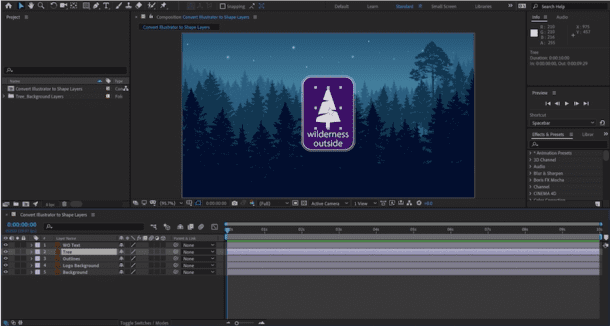
When viewing alpha information, the black area represents fully transparent sections while the white areas are fully opaque and gray areas are semi-transparent. This leaves only a black-and-white representation of the comp. From the list that appears, choose Alpha.Īll the RGB color information has been hidden because you are showing only the Alpha channel of the composition. You can change the display of the Composition panel to confirm which areas are transparent.Ģ With the Viewing Comp Alpha composition active, click on the Show Channel and Color Management Settings button ( ) located at the bottom of the Composition panel. In video programs, transparency is often referred to as Alpha, or the Alpha Channel. It is visible only in the area where the Photoshop document is transparent. The color blue that you can see behind the buildings is the background color of the composition itself. It was created from a Photoshop document that contains transparent areas. This composition includes a single layer named cityScene.psd. This makes the composition visible in the Composition panel and also reveals the comp timeline in the Timeline Panel.ĭouble-clicking on any composition in the Project panel makes thatĬomposition active in both the Composition and Timeline panels. Adjust Exposure.ġ With the lesson02_StartingProject-working still open, look in the Project panel and double-click on the composition named Viewing Comp Alpha to make it active. Show Channel and Color Management Settings.
#Adobe after effects tutorials titles getting started how to
In this exercise, you will work with the Composition panel to change the preview resolution of the display and learn how to reveal a composition’s alpha channel.Ī. This can all be accomplished in the Composition panel. Or maybe you need to isolate the alpha channel of your composition so that you can see which areas are transparent and which are opaque. Perhaps you want to create, show, or hide guidelines. You can build your animated projects in this panel, and it has features you can use to change how your composition previews. It is the preview window and the main animation space that you work in when building an After Effects project. The Composition panel is one of the most important panels in After Effects.

To help you better understand the panels, we’ve divided them into two groups: Primary panels, which you will use more frequently, and Secondary panels, which you will use less often. All the panels in After Effects are accessible through the Window menu. Some panels are for previewing footage or animation, and others set options for the tools, while others are for creating animation. The After Effects interface is divided into panels, where you will do most of your work.

The default After Effects workspace is named Standard. You can also set each panel to move or float, independently. The entire interface configuration is called a workspace, and After Effects includes a variety of pre-built workspaces to accommodate different working styles and tasks that you may need to accomplish. For more Adobe After Effects training options, visit AGI’s After Effects Classes.Īdobe After Effects Tutorial: Understanding the After Effects panel system in After Effectsīy default, After Effects uses a docked, panel-based interface to organize the work area. It is the second lesson in the Adobe After Effects CS6 Digital Classroom book. This tutorial provides you with a foundation for working with Adobe After Effects interface. What you’ll learn in this After Effects Tutorial:

Graphic Design for High School Students.


 0 kommentar(er)
0 kommentar(er)
